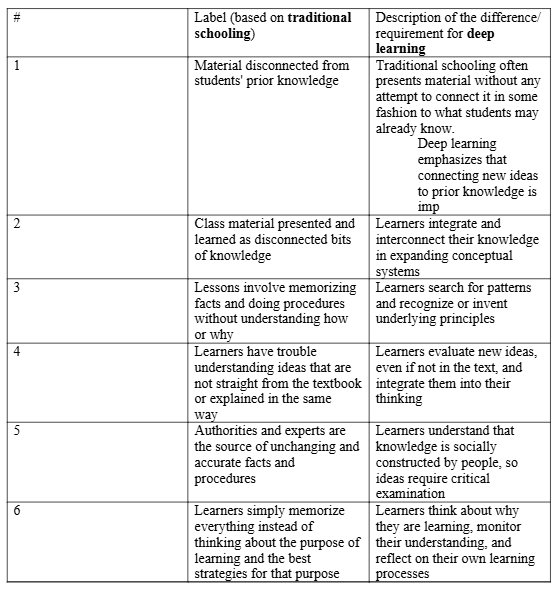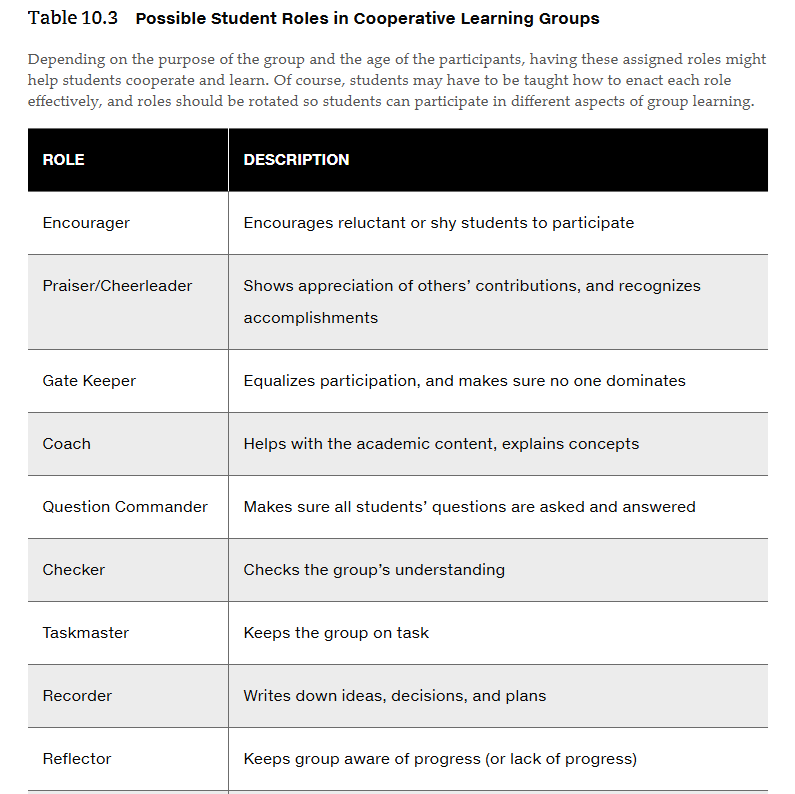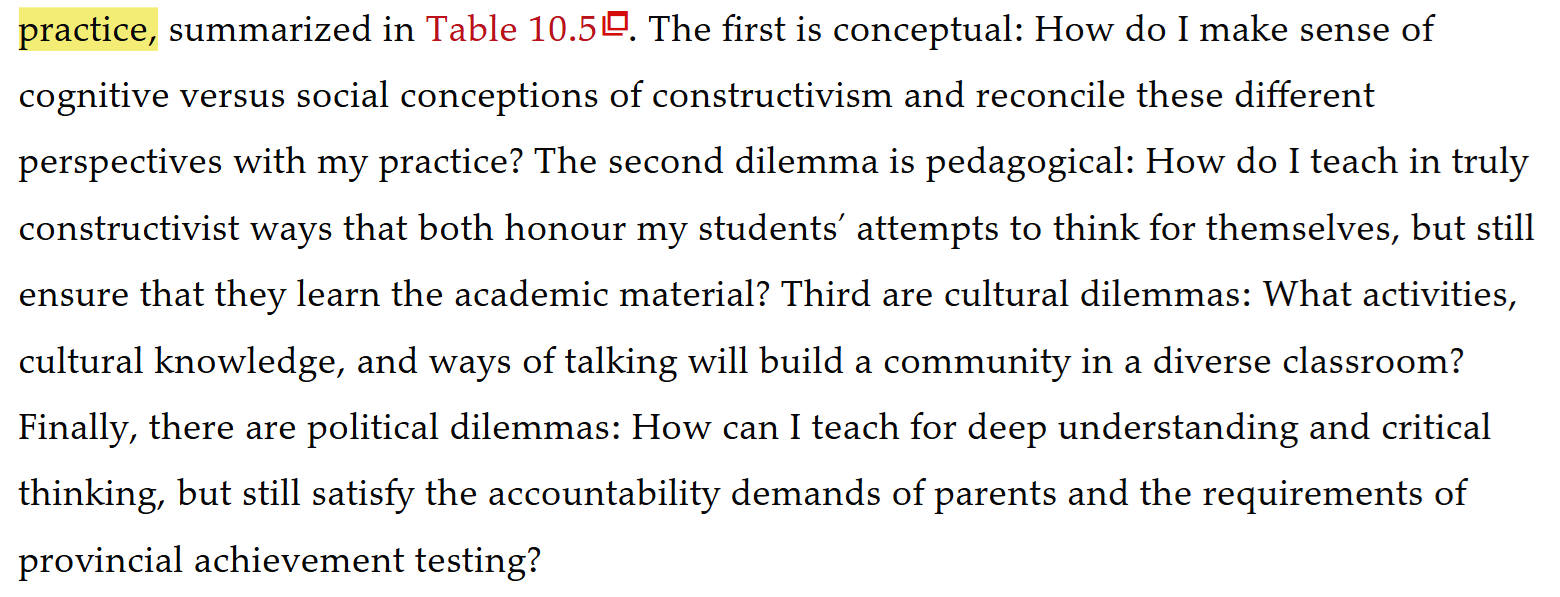Unit 10, chapter 10: Constructivism
1/41
Earn XP
Description and Tags
This textbook chapter is mostly about describing constructivist views of learning and providing concrete examples of instructional approaches that are consistent with that view.
Name | Mastery | Learn | Test | Matching | Spaced |
|---|
No study sessions yet.
42 Terms
Learning sciences
an interdisciplinary science of learning, based on research in various fields that study learning
bringing together work in many fields that study learning
one of the foundations of learning sciences is constructivism
Key/common assumptions in the learning sciences that allow researchers from a variety of disciplines to address same issue of learning from different perspectives
Experts have a deep conceptual Knowledge: allows them to put their knowledge in to action; can apply all they have learned/knowledge base to fit each situation/problem
Learning comes from the learner: Students must actively participate in their own personal construction of knowledge
Schools must create effective learning environments: create environment where students are active in constructing own deep understandings so they can reason about real-world problems and transfer knowledge
Prior knowledge and beliefs are key
Reflection is necessary to develop conceptual knowledge: students need to express and perform knowledge they are developing through performance, yet also through reflection (analyzing work and progress)
Constructivism
View that emphases the active role of the learner in building understanding and making sense of information
calls to attention the social and cultural aspects of learning
knowledge workers in the learning sciences are interested in ____
How deep knowledge in subjects (mat, literacy etc..) is learned/acquired and applied outside of the classroom/environment (in the real world)
deep learning
an educational approach that fosters a deep, meaningful understanding and connection of a subject/material
Table 10.1: How Deep Learning Contrasts with Learning in Traditional Classrooms (Sawyers analysis)

Embodied cognition
our cognitive processes have deep roots in the interactions of our bodies with the real world—what develops cognitively depends on our sensorimotor engagement with the world.
we have to understand our physical body interacts with the world (to achieve our goals) in order to understand our mind; as it also affects our thinking
conclusion that thinking is constructive comes from
The fundamental assumptions of the learning sciences and embodied cognition
two kinds of constructivism, and similarity
(1) Psychological/cognitive constructivism, and (2) social constructivism
cognitive constructivists (central idea 1)
individuals use information, resources, and help from others to build and improve their mental models and problem-solving strategies
concerned with how individuals make sense of the world, based on individual knowledge, beliefs, self-concept, or identity (first-wave constructivism)
knowledge comes from reflecting on and coordinating our own cognitions or thoughts
learning means individually possessing knowledge
Social constructivists (central idea 2)
view learning as increasing our abilities to participate with others in activities that are meaningful in the culture
Believe that social interaction, cultural tools, and activity shape individual development and learning—also called second-wave constructivism
By participating in a broad range of activities with others, learners appropriate the outcomes produced by working together; these outcomes could include both new strategies and knowledge
learning means belonging to a group and participating in the social construction of knowledge
appropriating
take for yourself knowledge and skills developed in interaction with others or with cultural tools
One way to integrate individual and social constructivism is to ____
think of knowledge as both individually constructed and socially mediated
What is situated learning
idea that skills and knowledge are tied to situation in which they were learned and that they are difficult to apply in new settings
learning in the real world is not like studying in school.
More like support of an expert guide and model, take on more and more responsibility until they can function independently.
Knowledge is viewed not as an individual’s cognitive structures, but rather as a creation of the community over time
learning means becoming more able to participate in practices and use the tools
How does situated learning relate to social constructivism, or the social context of learning and doing?
They both define learning as becoming familiar with and using the practices and tools of the community
that learning is most effective when embedded in context and activities that are social
that Knowledge byproduct of social interactions, culture, and context is used
Idea of situated learning affirms Vygotsky's notion that learning is inherently social and embedded in a particular cultural setting
If learning is very situated, then what would that imply about transfer?
That transfer is less likely to occur automatically and more likely to depend on similarity of original learning context and environment and the new situation
Since transfer is an important goal of learning, how should instruction address situated learning?
Integrate problem-centered activities within a social, collaborative environment
Describe each of the five common elements of constructivist, student-centered instruction
Complex learning environments and authentic tasks: complex problems should be embedded in authentic tasks and activities, the kinds of situations that students would face as they apply what they are learning to the real world.
Social negotiation and co-construction of knowledge: That higher metal processes develop through social negotiation (collaboration with others and respect for others perspectives)
Multiple perspectives and representations of content: help develop flexible understanding/ knowledge base. Comparing and contrasting activates prior knowledge, deepens comprehension, and builds a more robust cognitive map of the topic
Students should develop understanding of the knowledge construction process: Constructivist approaches emphasize making students aware of their own role in constructing knowledge. The assumptions we make, our beliefs, and our experiences shape what each of us comes to “know” about the world.
Students should have some ownership of their own learning: puts the students efforts to understand as the focus, but doesn’t mean the teacher abandons responsibility for the students
Describe scaffolding that constructivist approaches use
teacher does some aspect of the task that the learner isn’t yet able to do while still allowing the learner to solve the problem; they solve it together
provide just enough help and fade it—remove it—as learners become able to do more themselves
Fading
teacher gradually withdraws support as the students’ understanding and skills deepen, characteristic of scaffolding
three specific teaching approaches that put the student at the center and provide scaffolding
(1) Inquiry and learning, (2) Cognitive apprenticeships, (3) Cooperative learning
ill-structured problems:
complex, ambiguous, and lack single, clear-cut solution or solution path
How are ill-structured problems involved in complex, authentic tasks?:
Real-world challenges lack clear-cut definitions, solution paths and single correct answers
multiple parts to solution
How do authentic tasks differ from typical school tasks?:
authentic tasks are kinds of situations students would face as they apply what they learn to the real world
Inquiry (based learning)
Approach in which the teacher presents a puzzling situation and students solve the problem by gathering data and testing their conclusions.
Problem-based learning (PBL)
Methods that provide students with realistic problems that don't necessarily have “right” answers
problem is real and the students’ actions matter
stages of: challenges/question, student generate ideas, multiple perspectives added, students research and revise, get feedback from other students about conclusions, go public with info
Cognitive apprenticeship
a relationship in which a less experienced learner acquires knowledge and skills under the guidance of an expert
Modeling: observe an expert (usually the teacher) model the performance.
Coaching: external support through coaching or tutoring (including hints, tailored feedback, models, and reminders).
Scaffolding: gradually faded as the student becomes more competent and proficient.
3 other steps: articulating, reflection, and exploration
cooperation learning:
a way of working together with others to attain a shared goal.
three approaches: reciprocal questioning, Jigsaw classroom, and constructive controversy
Developing deep understandings in cooperative groups requires that all group members participate in high-quality discussions
Reciprocal questioning
Students work in pairs or triads to ask and answer questions about lesson material
Students in small reading groups learn four strategies: summarizing the content of a passage, asking a question about the central point, clarifying the difficult parts of the material, and predicting what will come next
goal is for students to learn to apply these strategies independently as they read so they can make sense of text
is example of collaborative learning, and of cognitive apprenticeship
Jigsaw classroom
A learning process in which each student is part of a group and each group member is given part of the material to be learned by the whole group. Students become “expert” on their piece and then teach it to the others in their group.
Constructive controversy
Students work in pairs within their four-person cooperative groups to research a particular controversy.
“inquiry” approaches are probably not very helpful except with especially knowledgeable or gifted/talented students?
Evidence shows that value of guidance and feedback depends on the student’s prior knowledge or age
students with some knowledge benefited more from just exploring solutions independently without feedback and guidance
Collaborative learning
means that the students are trying to work through ideas and solve problems together so that (1) differing ideas get noticed, (2) better ideas or solutions tend to get adopted, and (3) all of the students can contribute to the common goal and learn something along the way.
Why are ill-structured tasks and those that focus on social skills and communication ideal for cooperative learning?
because it requires a way of working with others to attain a common goal
How can the composition of the student group (and its size) affect social interaction and learning?
How large cooperative group is depends on goal
review, rehearse information, or practise, 4 to 5 or 6 students is about the right size.
But if the goal is to encourage each student to participate in discussions, problem solving, or computer learning, then groups of 2 to 4 members work best.
group includes some students who are perceived as different or who are often rejected, then it makes sense to be sure that there are group members who are tolerant and kind.
able 10.3: Possible Student Roles in Cooperative Learning Groups.

Explain how students learn how to ask (and answer) good questions in the reciprocal questioning approach.
After a lesson or presentation by the teacher, students work in pairs or triads to ask and answer questions about the material; teacher provides question stems, and then students taught how to develop questions on lesson material using these question stems (generic)
Students create questions and then take turns asking and answering
Encourage deeper thinking about the material
relate constructive controversy instructional approach to learning about argumentation
Similarities: argumentation and debates that foster greater learning
Differences: constructive controversy is a structured (work in pairs in 4 person group) process where participations argue viewpoints to find a solution through agreement, and emphases a cooperative context where goal is to implement differing ideas
What kinds of difficulties might students with learning disabilities have with cooperative leanring
require extra attention to planning and preparation, as those with disabilities have issues understanding new concepts, so when working in pairs/groups others and the student might get frustrated, potentially causing social rejection (also have issues with social relations)
teaching new or difficult-to-grasp concepts, cooperative learning might not be the best choice for students with learning disabilities
What kinds of difficulties might gifted students have with cooperative learning
may not benefit from cooperative learning when groups are mixed in ability.
The pace often is too slow, the tasks too simple, and there is just too much repetition.
In addition, gifted students often fall into the role of teacher or end up just doing the work quickly for the whole group
If you use mixed-ability groups and include gifted students, the challenges are to use complex tasks that allow work at different levels and keep gifted students engaged without losing the rest of the class
Table 10.5: Teachers’ Dilemmas of Constructivism in Practice. What are the four challenges (or dilemmas) that teachers face when considering constructivist teaching approaches?
Conceptual: Grasping the underpinnings of cognitive and social constructivism; reconciling current beliefs about pedagogy with the beliefs necessary to support a constructivist learning environment.
Pedagogical: Honoring students’ attempts to think for themselves while remaining faithful to accepted disciplinary ideas
Cultural dilemmas: Conscious of the culture of your classroom;
Political dilemmas: Confronting issues of accountability with various stakeholders in the school community; negotiating with key others the authority and support to teach for understanding.

What are some things to consider when planning for cooperative learning
Fit group size and composition to learning goals
Assign appropriate roles
Make sure you assume a supporting role as the teacher
Move around the room, and monitor the groups
Start small and simple until you and the students know how to use cooperative methods